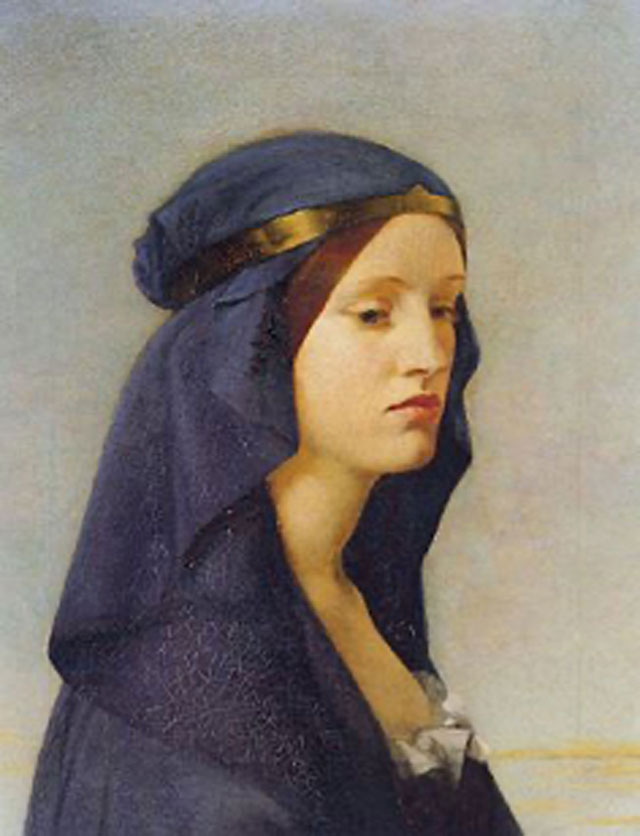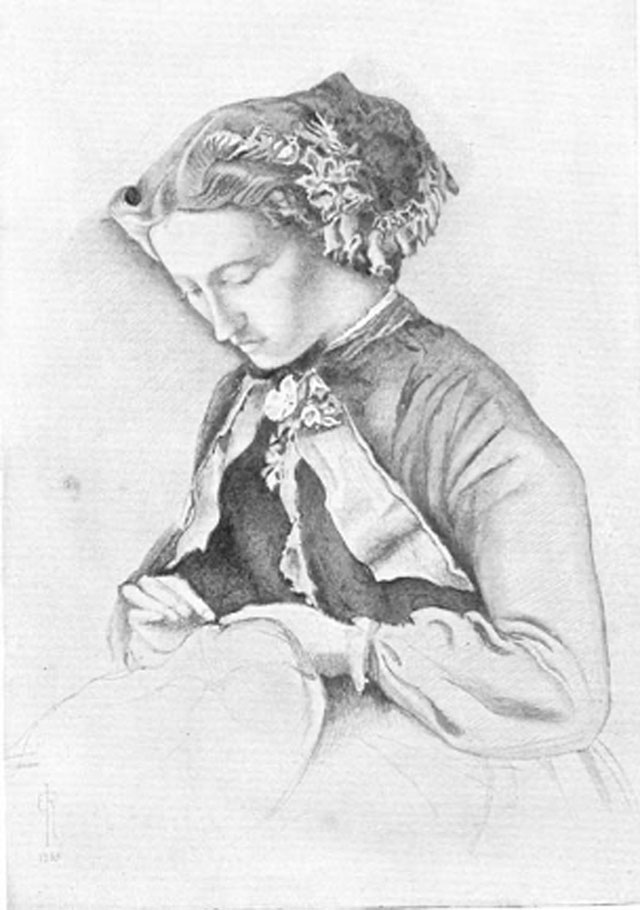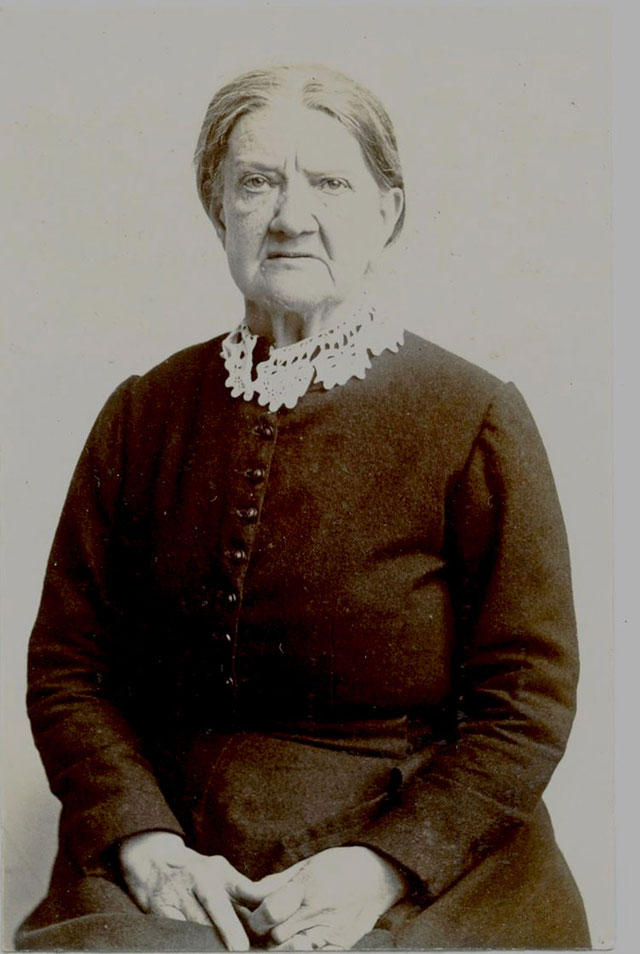Joanna Boyce’s Elgiva (Fig. 1), depicting a persecuted Anglo-Saxon queen, was exhibited at the Royal Academy in 1855 and described by Ford Madox Brown as ‘the best Head in the room’.1 Boyce, who spent several years avoiding marriage so she could focus on developing her work as an artist, died following the birth of her third child at the age of twenty-nine. She is an attractive figure for feminism, having refused to give up on her artistic ambitions on becoming a parent, and claiming ‘no man has a right’ to deny a woman the opportunity to follow her creative and professional desires.2 Despite her talents, Boyce’s work is little featured in histories of Pre-Raphaelitism. Elgiva, however, is one of many paintings by female artists featured in the recent ‘Pre-Raphaelite Sisters’ exhibition at the National Portrait Gallery (17 October 2019–26 January 2020), which claims to be ‘the first ever to focus on the untold story of the women of Pre-Raphaelite art’.3 Specifically, the show sets out to explore ‘the overlooked contribution of twelve women to the movement’.4 These women are: Joanna Wells (née Boyce), Fanny Cornforth, Marie Spartali Stillman, Evelyn De Morgan, Christina Rossetti, Georgiana Burne-Jones, Effie Millais, Elizabeth Siddal, Maria Zambaco, Jane Morris, Annie Miller, and Fanny Eaton. The exhibition features artworks from public and private collections, some on view for the first time.
The chief aim of the exhibition is to explore ‘the significant roles’ Pre-Raphaelite women played ‘as artists, models, muses and helpmeets who supported and sustained the artistic output of the Pre-Raphaelite Brotherhood’. While the framing of the concept of ‘roles’ is sometimes simplistic — the exhibition catalogue states that ‘each woman occupies a creative role within the Pre-Raphaelite movement; some held more than one role’ (p. 8) — the idea of women as a hidden support network for the male Pre-Raphaelites is a valid one.
Each woman profiled in the exhibition has a room, or section of a room, dedicated to them, featuring works either produced by the figure or in which they appear (as themselves or as a model). Each character is introduced via a text panel at the opening of the room, and via words which appear above her name. For example, Effie Gray Millais is ‘Model, Wife, Manager’, while Christina Rossetti is ‘Poet, Sister, Model’. It is clear that each of these terms is meant to be empowering to the women involved. Indeed, one exhibition panel gives a definition of a Pre-Raphaelite ‘Muse’ as a model forming ‘a creative partnership with a painter, her presence inspiring his art. Her face featured repeatedly in pictures, as emblem of the collaborative process.’ This exhibition then, seems to be an act of recuperating the presence of women in Pre-Raphaelite art, embracing the idea of a muse, in marked contrast to approaches by Deborah Cherry and Griselda Pollock, who made feminist readings, in part informed by psychoanalysis, of Pre-Raphaelite depictions of women — especially those by Dante Gabriel Rossetti — as instruments of an obsessive male gaze.5
Where possible, an emphasis is made in the exhibition on Pre-Raphaelite women as producers. For example, in the section on Georgiana Burne-Jones, we learn of her studies under Ford Madox Brown, her visit to Italy with friends Jane Morris and Elizabeth Siddal, and their plans to produce an illustrated volume of fairy tales. On display are works by Georgiana not often seen: for example, a drawing of a finch (1859, in the Tate collection) and an illustrated poem (1859, now in the British Museum). The inclusion of women as producers offers a corrective to the large 1984 exhibition and the 2012 exhibition on Pre-Raphaelitism, both at Tate, and neither of which considered in any depth women as producers.
Another novel theme of the exhibition is that of presenting the women concerned in roles such as ‘manager’, given that women such as Georgiana Burne-Jones in effect acted as business managers for their artist-husbands. This route of enquiry offers great potential for a reappraisal of the significance of women’s professional activities. For example, while it is well known that Georgiana supported Edward Burne-Jones in a professional capacity, it is less known that Effie Gray Millais acted as a manager of her husband’s career, as explained in the opening panel of the Gray Millais room. The room, however, does not really speak to this role; instead, it contains a range of mainly familiar artworks, mostly by Millais, using Effie as a model, and text labels which comment mainly on the works rather than the sitter. It is possible that the omission of relevant material is due to a lack of artefacts relating to Effie’s role as manager, although it would seem likely that letters, diaries, or account books may have survived. The room also contains an accomplished copy, in pencil, by Effie, of a Millais painting, The Foxglove (Fig. 2).
Effie Ruskin, copy of The Foxglove, 1853. Scanned image by George P. Landow at <http://www.victorianweb.org/painting/millais/drawings/55.html>.
Despite a desire to present Pre-Raphaelite women as producers and administrative workers, there is a sense in which biographical frameworks still loom large in the exhibition. For example, one of the aims of the exhibition is the rather simplistic one of setting out to ‘reveal […] the women behind the pictures’. Likewise, the idea of discovering what the women ‘really look[ed] like’ (another aim of the exhibition) is problematic given that we can only know the women through mediated images.
Biographical routes of investigation have been crucial in recovering the women associated with Pre-Raphaelitism. Studies such as Lucinda Hawksley’s Lizzie Siddal: The Tragedy of a Pre-Raphaelite Supermodel (2004), Jan Marsh’s Pre-Raphaelite Sisterhood (1985), and Kirsty Stonell Walker’s Stunner: The Fall and Rise of Fanny Cornforth (2006) have been important here. But with so much biographical work undertaken, arguably the focus for exhibitions might now profitably shift to investigating the figures on similar terms to those of their male colleagues: for example, art historical contextualization and sophisticated formal analysis. This is especially the case given that even biographical accounts of male Pre-Raphaelite artists connect their work to serious artistic concepts, such as Fiona MacCarthy’s The Last Pre-Raphaelite: Edward Burne-Jones and the Victorian Imagination (2011) and Rossetti: Painter and Poet (2011) by J. B. Bullen. The ‘Pre-Raphaelite Sisters’ exhibition catalogue does create some space for discussing the artists’ work in art historical and formal terms, although the preceding thematic essays take up the popular tropes of models, wives, and mistresses.
Perhaps the most relevant aspect of ‘Pre-Raphaelite Sisters’ to 19 Live is the aim of the exhibition, and accompanying publication, to elucidate ‘the Pre-Raphaelite movement for our current moment, as a thoroughly more open, inclusive and diverse undertaking, whose advancement depended fundamentally on the endeavours of women as models, artists and creative partners’ (Marsh and others, p. 6). This is a fascinating premise, and it is well worth revisiting Pre-Raphaelitism through the lens of inclusivity, as indeed current scholarly approaches are attempting to do. Certainly, the attitude of male Pre-Raphaelite artists to women as producers of art was progressive. However, the sexual double standards of some of the male artists problematizes the idea of inclusivity, or at least draws attention to its limits. For example, to see, in the exhibition’s section on Maria Zambaco, Edward Burne-Jones’s portrait of her in his studio displayed in close proximity to the section on Georgiana Burne-Jones is an uncomfortable reminder of the sexual liberties Burne-Jones enjoyed while his wife managed his business affairs and enabled his continued professional success. Likewise, Dante Gabriel Rossetti’s portrait of Maria produced for Edward makes apparent the ways in which images of women were circulated and exchanged among some members of the group.
The questions with which this exhibition is concerned — including ‘How did these women relate to the images? What did they really look like? How did they become involved? How did they fare?’ — are difficult ones to answer via the exhibition display alone. While the catalogue addresses some of these questions, the curators’ chief vehicle for communicating ideas is the objects themselves, rather than copious amounts of text. In this respect, objects and sources other than artistic outputs can be very helpful in animating the lives of Pre-Raphaelite women, in contrast to the (often glamorized) paintings of them by male artists. One of the most successful rooms in this respect is the one devoted to Fanny Cornforth. The room contains the expected images of Fanny, by Rossetti, but more striking was an original hospital casebook, now owned by West Sussex Record Office, which vividly describes Fanny (by then Sarah Schott/Sarah Hughes) on her admission to Graylingwell Hospital: ‘she has a bad temper’, is ‘deaf’, ‘weak minded’, has ‘no memory’, is ‘stout and well nourished’ with ‘skin dirty’ and ‘breath foetid’, and has ‘large varicose veins’.6 The record is accompanied by a photograph of Fanny on her admission (Fig. 3). The document offers a fascinating record of a real and aged body. Even in old age, the body of Fanny/Sarah was being scrutinized, albeit in a very different way to the erotic gaze of Rossetti. Furthermore, her body was a working-class one. Although class is not an explicit theme of the exhibition, there is an evident contrast between the experience of those women who were working class in origin — Annie Miller, Jane Morris, Fanny Cornforth — and those who were middle or upper class such as Marie Spartali Stillman, Joanna Boyce, and Evelyn De Morgan.
‘Pre-Raphaelite Sisters’, although simplistic in some of its aims, is important in its resolute focus on the women associated with Pre-Raphaelitism, its attempt to reconceptualize the roles those women played, and its positing of the idea of inclusivity. It succeeds in increasing the visibility of the female artists, writers, and models associated with Pre-Raphaelitism and therefore in expanding our knowledge of Pre-Raphaelite artistic production.
Notes
- Sue Bradbury, Joanna, George and Henry: A Pre-Raphaelite Tale of Art, Love and Friendship (London: Boydell Press, 2012), p. 75. [^]
- Jan Marsh and others, Pre-Raphaelite Sisters, exhibition catalogue (London: National Portrait Gallery, 2019), p. 93. [^]
- ‘Pre-Raphaelite Sisters’ <https://www.npg.org.uk/whatson/pre-raphaelite-sisters/exhibition/> [accessed 4 May 2020]. [^]
- Introductory exhibition panel. Unless otherwise stated, all quotations relating to the exhibition are from the exhibition wall panels. [^]
- See Deborah Cherry and Griselda Pollock, ‘Patriarchal Power and the Pre-Raphaelites’, Art History, 7 (1984), 480–95; and Griselda Pollock (with Deborah Cherry), ‘Woman as Sign in Pre-Raphaelite Literature: The Representation of Elizabeth Siddall’, in Griselda Pollock, Vision and Difference: Feminism, Femininity and the Histories of Art (Oxford: Routledge, 1988), pp. 91–114. [^]
- Graylingwell casebook, Chichester, West Sussex Records Office. [^]



